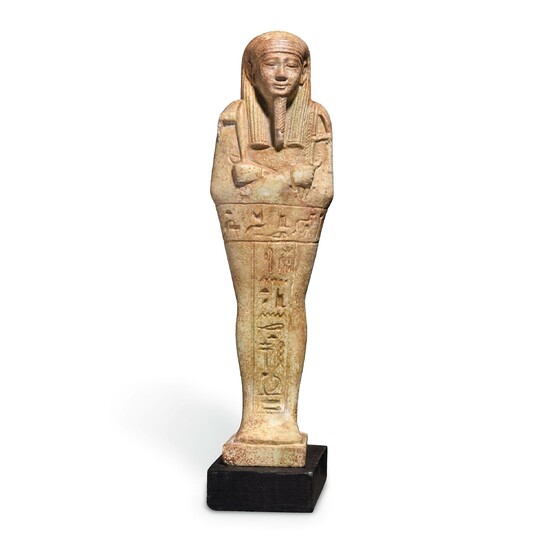OUSHABTI AU NOM DU CHANCELIER ROYAL HOROUDJA NÉ D’ISETENMÉHYT Egypte, XXVIIe-XXXe dynastie, IVe siècle av....
OUSHABTI AU NOM DU CHANCELIER ROYAL HOROUDJA NÉ D’ISETENMÉHYT
Egypte, XXVIIe-XXXe dynastie, IVe siècle av. J.-C.
Faïence siliceuse à glaçure verte
H. 13,9 cm
Provenance
Ancienne collection française, acquis dans les années 1960-1970
Puis par succession
Collection privée française, acquis lors de la vente de cette succession
Dans sa gaine momiforme. Il porte la perruque tripartite striée et une barbe postiche tressée (léger manque). Les mains croisées tiennent les instruments aratoires. Les jambes sont gravées d’une inscription hiéroglyphique en T avec nom, titulature et filiation. Les oushebti du chancelier de Basse
Égypte Horoudja ont été découverts durant la deuxième moitié du XIXe siècle, probablement à Gizeh. Ce haut dignitaire nous a laissé deux séries d’oushebti : de grands spécimens avec le chapitre VI, et de plus petits pourvus d’une inscription en T avec titulature et filiation.
Bibliographie comparative
J. L. Aubert, Statuettes funéraire, Paris, 1974, p. 254. J. L. Chappaz, Les figurines funéraires égyptiennes du musée d’art et d’histoire et de quelques collections privées, Genève, 1984, pp. 116-117, n° 149-150.
An egyptian green faience glazed shabti for the Royal Chancellor of Lower Egypt, Horudja born of Isetenmehyt. In its mummiform sheath. He wears the striated tripartite wig and a braided false beard (slight lack). The crossed hands hold the hoes.
The legs are engraved with a hieroglyphic T-shaped inscription with name, title and filiation. The Ushabti of Chancellor of Lower Egypt Horoudja were discovered during the second half of the 19th century, probably in Giza. Probably Giza, Dynasty XXVII-XXX, ca. 4th century B.C
View it on
Estimate
Time, Location
Auction House
OUSHABTI AU NOM DU CHANCELIER ROYAL HOROUDJA NÉ D’ISETENMÉHYT
Egypte, XXVIIe-XXXe dynastie, IVe siècle av. J.-C.
Faïence siliceuse à glaçure verte
H. 13,9 cm
Provenance
Ancienne collection française, acquis dans les années 1960-1970
Puis par succession
Collection privée française, acquis lors de la vente de cette succession
Dans sa gaine momiforme. Il porte la perruque tripartite striée et une barbe postiche tressée (léger manque). Les mains croisées tiennent les instruments aratoires. Les jambes sont gravées d’une inscription hiéroglyphique en T avec nom, titulature et filiation. Les oushebti du chancelier de Basse
Égypte Horoudja ont été découverts durant la deuxième moitié du XIXe siècle, probablement à Gizeh. Ce haut dignitaire nous a laissé deux séries d’oushebti : de grands spécimens avec le chapitre VI, et de plus petits pourvus d’une inscription en T avec titulature et filiation.
Bibliographie comparative
J. L. Aubert, Statuettes funéraire, Paris, 1974, p. 254. J. L. Chappaz, Les figurines funéraires égyptiennes du musée d’art et d’histoire et de quelques collections privées, Genève, 1984, pp. 116-117, n° 149-150.
An egyptian green faience glazed shabti for the Royal Chancellor of Lower Egypt, Horudja born of Isetenmehyt. In its mummiform sheath. He wears the striated tripartite wig and a braided false beard (slight lack). The crossed hands hold the hoes.
The legs are engraved with a hieroglyphic T-shaped inscription with name, title and filiation. The Ushabti of Chancellor of Lower Egypt Horoudja were discovered during the second half of the 19th century, probably in Giza. Probably Giza, Dynasty XXVII-XXX, ca. 4th century B.C



